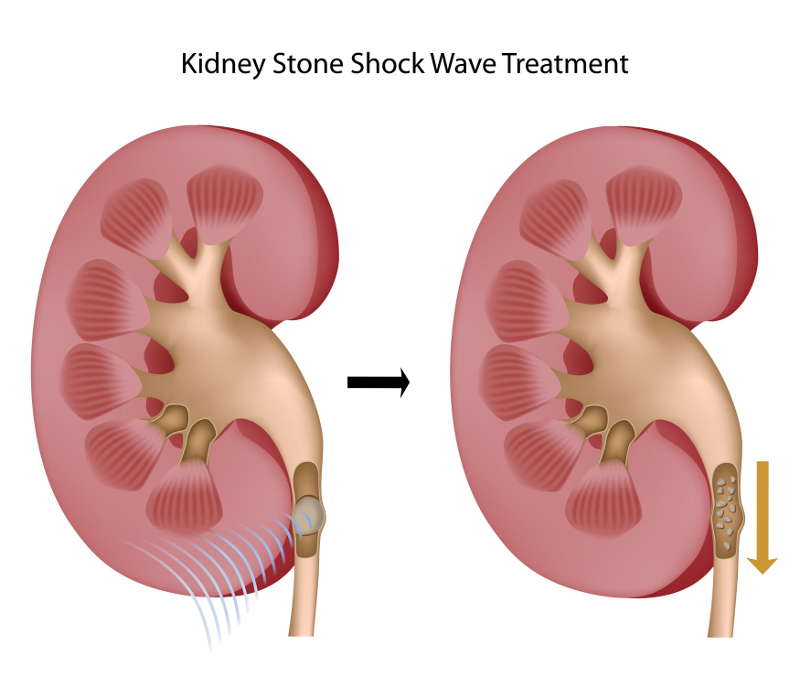Treatment for kidney stones (or crystallized masses) depends upon the size, location and type of stone. These hard, pebble-like deposits of salts and minerals can be as small as a grain of sand, or as large as a golf ball. Smaller kidney stones, especially those under 4 millimeters in diameter, are more likely to pass in the urine on their own. Larger kidney stones, however, may need to be broken apart first.
Treatment of Small Kidney Stones
In most cases, if the stones are small, the doctor will take a watch-and-wait approach. This, however, does not mean do nothing. Passage of these smaller stones can be aided by:
- Drinking more fluids (the urine should be clear or pale yellow)
- Pain medicines to ease the discomfort
- Other medications (such as alpha blockers) to relax the muscles of the ureter, the tube that carries urine from the kidneys to the bladder
The patient may also be asked to strain their urine to collect any stones or particles so as to know when a stone has passed. However, a follow-up visit that includes an exam, x-ray, and/or CT scan can confirm that the stone is officially gone.
Treatment of Larger Kidney Stones
Larger kidney stones are less likely to pass from the body on their own, and may become stuck in part of the urinary tract. Left untreated, these stones can cause severe damage to the kidney when pressure from unpassed urine builds up behind the stone.
Hospitalization is not usually needed, except in cases of:
- Severe kidney infection
- Blockage of one or both kidneys by the stone
- Kidney failure
- Severe pain that doesn’t respond well to pain medicines
Shock Wave Treatment of Larger Kidney Stones
Larger stones may need to be broken apart in order for the pieces to pass from the body in the urine. Shock wave treatment (also known as extracorporeal shock wave lithotripsy) uses pulses of sound to break apart the kidney stone. These shock waves pass through the body from the outside, therefore the procedure doesn’t require surgery. However, some patients may be given medication or general anesthesia to help them relax or sleep.
 Shock wave treatments (lithotripsy) can be done in a hospital, clinic or mobile unit, and takes about an hour. Usually, an overnight hospital stay is not required.
Shock wave treatments (lithotripsy) can be done in a hospital, clinic or mobile unit, and takes about an hour. Usually, an overnight hospital stay is not required.
Before the procedure, the patient might be given IV (intravenous) fluids, and a flexible tube (stent) might be placed inside the ureter to keep the urine flowing.
During the procedure, the patient will lie either on a fluid-filled cushion or in a special bathtub filled with warm water. After the kidney stone is located using ultrasound or an x-ray, shock waves are aimed at the stone. If the patient is awake during the procedure, he will feel only a tapping sensation.
Once the stone is broken, the fragments will pass in the urine anywhere from one day to several weeks later. The patient will be given instructions from the the doctor telling him what to do during recovery, such as drink plenty of fluids. One or more follow up visits will be necessary to ensure that the stone has officially passed and that no new stone has developed.
The main risks with shock wave treatment are infection, bleeding or bruising of the kidneys, blockage of the ureter, or the stone not breaking into pieces.
Kidney Stones Warning Signs
While waiting for a kidney stone or its fragments to pass, patients should contact a doctor immediately if they experience any of the following:
- Pain in the abdomen or groin that increases or is so severe that pain medicine doesn’t help
- Fever
- New pain in the abdomen
- Fainting
- Difficulty urinating
- Nausea or vomiting
- Heavy bleeding in the urine
Reducing Your Risk of Kidney Stones
Several dietary steps can help reduce a person's risk of kidney stones, including:
- Drinking 12 or more glasses of water a day
- Limiting sugar and high-fructose corn syrup in your diet
- Decreasing salt intake
- Maintaining a healthy weight
- Avoiding too much dietary protein
References
Emmett M, Fenves AZ, Schwartz JC. Approach to the Patient with Kidney Disease. Brenner and Rector's The Kidney, 9th ed., 2011.
Hall P. Nephrolithiasis. Cleveland Clinic: Current Clinical Medicine, 2nd ed. 2010.


